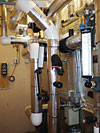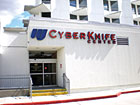
The CyberKnife building requires extremely precise
temperature and humidity control that is difficult to obtain with a traditional
HVAC system. West Jefferson chose the Trane CDQ™ desiccant dehumidification
system to help stabilize the building’s humidity levels in order to meet the
stringent requirements.
For instance, the board of Evans Memorial Hospital, a 49-licensed bed acute care hospital in Claxton, Ga., part of the Hometown Health Network, found a solution for all three by engaging in a performance-based contract that is designed to fund much-needed renovations through energy savings.
In a different example, West Jefferson Medical Center (WJMC), a non-profit community hospital in Marrero, La., had to deal with humidity control issues at its new CyberKnife Center - and hospital officials knew it had to resolve the issue in both an energy-efficient and cost-effective manner. In this instance, the center turned to a desiccant humidification system that, in the end, provides needed results in a timely manner.
Meanwhile, the Avalon Nursing Center, an 83-bed skilled nursing facility in New Castle, Pa., had a problem with airborne germs and viruses, as well as the odors associated with them. After examining all options, it turned to an energy recovery fresh air ventilation system, which has proven to take care of the problem - in an energy-efficient way.
Here is a closer look at the issue each hospital faced and how each resolved their respective indoor air problem.
CHALLENGES AT EVANS
At Evans Memorial Hospital, CEO Martha Tatum faced several issues. Among other concerns, two 1960s vintage Trane chillers were serving the critical areas of the hospital. The American Society of Heating, Refrigerating and Air-Conditioning Engineers (ASHRAE) rates the useful life of a chiller in the range of 20-25 years, so both of the hospital’s chillers had doubled this recommended lifespan.The age of these chillers raised concern about their ability to meet the critical need for controlled temperature and relative humidity in the surgical suites. Hospital management decided to address the situation before a serious failure occurred.
“Health care facilities are constantly trying to find ways to cut costs while continuing to provide quality, compassionate health care. This usually means maintenance and upgrades to facilities end up at the bottom of the list,” said Tatum.
“We recently found ourselves in this exact situation with aging facilities lacking modern, energy-efficient technology and a very real possibility that some of our systems would fail and not work again. We saw an opportunity to solve this, save on energy, and improve building systems through an energy project with Trane.”
In addition to the urgency of the situation, other challenges included:
• designing a budget-neutral solution that would meet the payback requirements;
• working in the very limited space of the existing mechanical room;
• maximizing the efficiency of the new system to achieve the necessary energy savings; and
• addressing the lack of redundancy in order to enhance the system reliability and minimize potential downtime.
SOLUTIONS AT EVANS
To begin the facility analysis, the Trane design team examined several aspects of the hospital’s infrastructure to identify areas in which savings could be generated to support a budget-neutral solution. Several potential areas were identified and selected with the input of the hospital’s administration and board.The final solution included the installation of a large chiller that is manufactured by Sparta, Wis.-based Multi-stack, along with a new larger cooling tower. The Multi-stack chiller was selected for its high efficiency and compact design. According to hospital officials, the energy usage of the new chilled water system is approximately one-half of the energy used by the old system.
Several additional benefits incorporated within the new design included:
• Multiple compressor design was installed to enhance redundancy. The new system can actually lose a compressor and still provide proper conditions in the critical areas served, according to Tatum.
• New pumping design, designed to prevent a single pump from causing a system failure.
• Cooling connections were installed to allow connection of a temporary chiller in the event of emergency conditions.
According to hospital officials, the improvements result in a kWh reduction of 17 percent. According to Trane, this is equivalent to saving 725 tons of carbon dioxide annually, taking 143 cars off the road or eliminating 85 households’ electricity use for one year.
Savings will be achieved through Trane’s performance contracting, which is a guaranteed energy-savings contract designed to help building owners create high-performance environments while significantly reducing energy and operating costs. Cost savings fund facility enhancements are included in the contract.
By reducing energy and operating costs, it is anticipated that the $1.84 million in renovations on the 80,000-square-foot facility will pay for themselves over 13 years. This makes Tatum smile.
“We look forward to the realization of savings from the completed project,” said the hospital’s CEO. “We feel, however, that the most beneficial improvement will not be measured in savings but will be realized by our patients and personnel, and we are proud of that.”

West Jefferson Medical Center constructed a facility to
house its state-of-the art CyberKnife tool. CyberKnife technology is in use in
just 20 leading cancer treatment centers nationwide.
HUMIDITY PROBLEMS AT WEST JEFFERSON
A humidity issue surfaced at West Jefferson Medical Center (WJMC), which has been named among the best hospitals in the United States in recent years. The hospital recently installed the revolutionary CyberKnife robotic surgery system - the CyberKnife system is the world’s first and only dedicated radiosurgery device.The robotic surgery is designed to help treat benign tumors, malignant tumors, and other medical conditions. The system combines image guidance technology and computer-controlled robotics to enable delivery of high doses of radiation with sub-millimeter precision. Thanks to this accuracy, hospital officials said multiple areas of the body can be treated non-invasively, including the brain, spine, lung, prostate, liver, and pancreas.
Because the CyberKnife uses ion chambers that are vented to the atmosphere, changes in atmospheric pressure and X-ray head temperature can affect output. According to hospital officials, extremely precise control of operating room temperature and humidity are essential. In Louisiana, where outdoor relative humidity seldom falls below 50 percent, keeping humidity at the correct levels is a major HVAC challenge.
“After installing the CyberKnife system, we realized that we did not have adequate humidity control. We needed a solution quickly,” said Ronny Gann, former director of facilities management at WJMC.
In this case, Gann contacted Trane’s New Orleans office to help stabilize humidity levels.
“We called on Trane because we’ve had a long, successful facilities management relationship with them,” explained Gann.
SOLUTIONS AT WEST JEFFERSON
According to Gann, the project turned out to be an “ideal application” for the company’s new CDQ™ system. According to Trane, its new desiccant dehumidification product is designed for facilities requiring lower dew point settings “and can increase cooling coil capacity by 20 to 30 percent.” With the system, chilled water temperatures can be set higher; all designed to save energy and eliminate reheat or exhaust air, it said.Standard air conditioning coils have limited dehumidification capacity. The air dew point cannot be lower than the coil temperature - this is the dew point barrier. According to Trane, its CDQ system “breaks this dew point barrier using an energy recovery desiccant wheel that transfers humidity from the supply air to the return air or mixed air.” As a result, the cooling coil can remove up to 200 percent more moisture per hour, it said.
WJMC is also equipped with Trane’s CenTraVac™ chillers, Summit™ building automation system and its air-handling units.
Since installation of the system, the hospital said it has not received a single complaint from the surgical staff about the surgical environment. WJMC surgeons and patients can now take advantage of the CyberKnife system benefits whenever needed without worrying about humidity concerns.
“Trane performed admirably,” said Gann. “They had one weekend to get the CDQ equipment installed, and it was to be up and running by 7 a.m. on Monday morning. Actually, the installation was completed on Sunday afternoon.”
NEW VENTILATION SYSTEM TO RESCUE
At Avalon Nursing Center, the task was reducing the risk of airborne germs and viruses, as well as odors. Skilled nursing facilities like Avalon are required by Pennsylvania state law to provide at least 30 percent inflow of fresh air. As hospital officials will tell you, constantly heating or cooling outside air for inside use can be extremely costly.In this case, the hospital turned to Berner for an answer. The manufacturer suggested its energy recovery ventilation system. By attaching an air exchange to a traditional conditioning unit, the solution allows the nursing center to enjoy 100 percent fresh, odor-less air, while reducing the utility costs associated with heating and cooling it.
According to the manufacturer, the complete exchange of air that its system provides for the center “removes pathogens and provides air that has more oxygen in it.” The manufacturer maintains that fewer pathogens mean fewer illnesses, and more oxygen means more energy and productivity, “which is a huge benefit to any company.”
But it gets even better, according to the nursing staff. Having cleaner, odor-free air is a major selling point. Now when Avalon is interviewing prospective residents or employees, the facility’s noticeably fresh atmosphere could be considered a recruiting tool.
For more information, visit www.trane.com/commercial and www.bernerenergy.com.
Publication date:11/03/2008

Report Abusive Comment